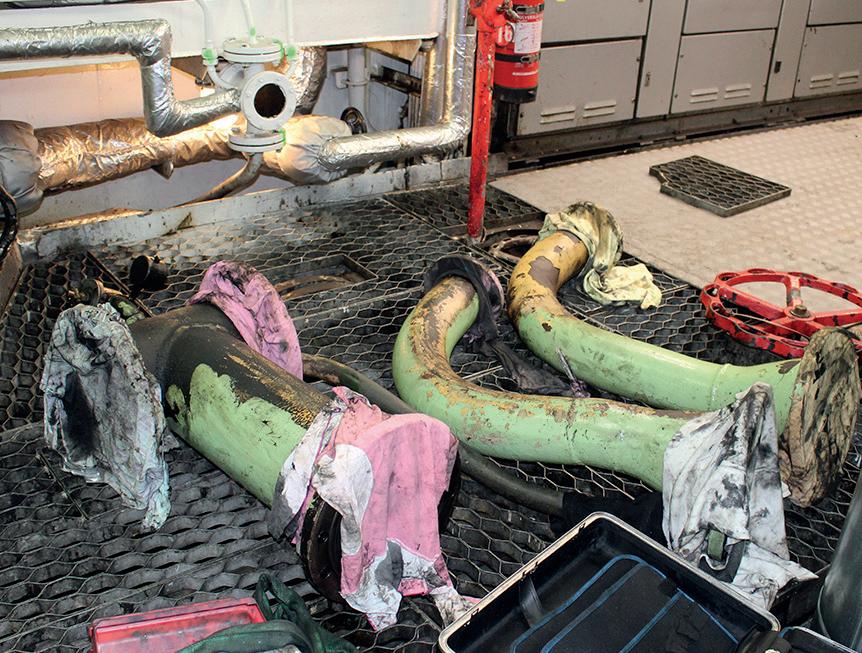
3 minute read
In English: Security
from Sjöbefälen nr 1 2020
by Sjöbefälen
Stena Bulk will not change its risk assessments after the incident with Stena Impero. But it is clear the incident has had an impact. TRANSLATED BY CURT ISAKSSON
Advertisement
“Soldiers came on board with sharpened weapons and the crew experienced initially that the situation was hostile. This was an incident that one initially didn’t think was true, and it was extremely stressful for everyone involved,” says Erik Hånell, managing director at Stena Bulk. On July 19, 2019 small boats and a helicopter came close to the Swedish owned and British flagged Stena Impero on Omani water in the Strait of Hormuz. With a crew of 23 persons from India, Russia, Latvia and the Philippines, Stena Impero was forced to go to the Iranian port Bandar Abbas.
“We have never received any official explanation. However, there have been some comments in the media, among others in Iran, and we have responded to that,” says Hånell.
What is mentioned in the media is that Stena Impero should have collided with a fishing boat, that there came oil spill from the ship, that the communication system wasn’t turned on and that the ship was on Iranian water. According to Hånell, Stena Bulk has made its own investigations, which show that the accusations aren’t correct. Stressful to be in a state of ignorance According to Hånell, the crew was treated physically well. But mentally it was hard. “It was stressful to be in a state of ignorance and probably there wasn’t any access to completely transparent information,” he says.
Erik Hånell says that something decisive happened on August 20, 2019. Swedish authorities had then arranged a meeting between Hånell and the Iranian Foreign Minister on a visit to Sweden. “We had direct contact with Iranian authorities after that meeting. We had a dialogue about what was required for the ship to be released,” says Hånell.
According to Hånell, the request was that Stena Bulk should be available in the future, if new evidence showed that the ship had done something wrong.
On September 5, seven persons of the crew were released and on September 27 it was confirmed that the rest of the crew had been released and that Stena Impero had left Iranian water. Despite the incident Stena Bulk is not planning to introduce any new risk routines for high-risk areas.
“Of course, an incorrect assessment had been made, as this happened. But I see no reason to change the process. I think that we are professional and take many sources into account when we go into high-risk areas, which we do very often,” says Hånell. Soldiers came on board with sharpened weapons and the crew experienced initially that the situation was hostile. ”
Information used by Stena Bulk comes from authorities of different countries, local authorities in risk areas and private security companies. According to Hånell, the routines on board the ships of Stena Bulk have above all been developed since 2009-2010, when the piracy was intense.
“There is a procedure even if authorities come on board. In this case Iran put people on board the ship and the captain then made sure that everyone entered the bridge. He acted very professionally and according to all routines,” says Hånell.
Had a standby crew When it comes to salaries and benefits of the crew, has such an incident as the one with Stena Impero any impact? Has the crew gotten any compensation?
“No, there isn’t any impact,” says Hånell. “Our priority throughout the process was to free the crew, preferably also the ship, but the crew was number one priority. We were completely transparent with information to relatives,” says Hånell.
“We had among other things a crew standby that could take over on the ship if this had been possible,” says Hånell.
The capacity ought to be higher Even if the managing director at Stena Bulk don’t thinks it is likely with a similar incident as the one with Stena Impero in the Baltic Sea, he gets concerned when he is informed that the demining capability of the Swedish Armed Forces in some situations is limited to one passage, one port and a few hundred meters of quay. “Disturbing. If contrary to expectations something was to happen, the capacity ought to be considerably higher, otherwise Sweden will stop,” says Erik Hånell.






